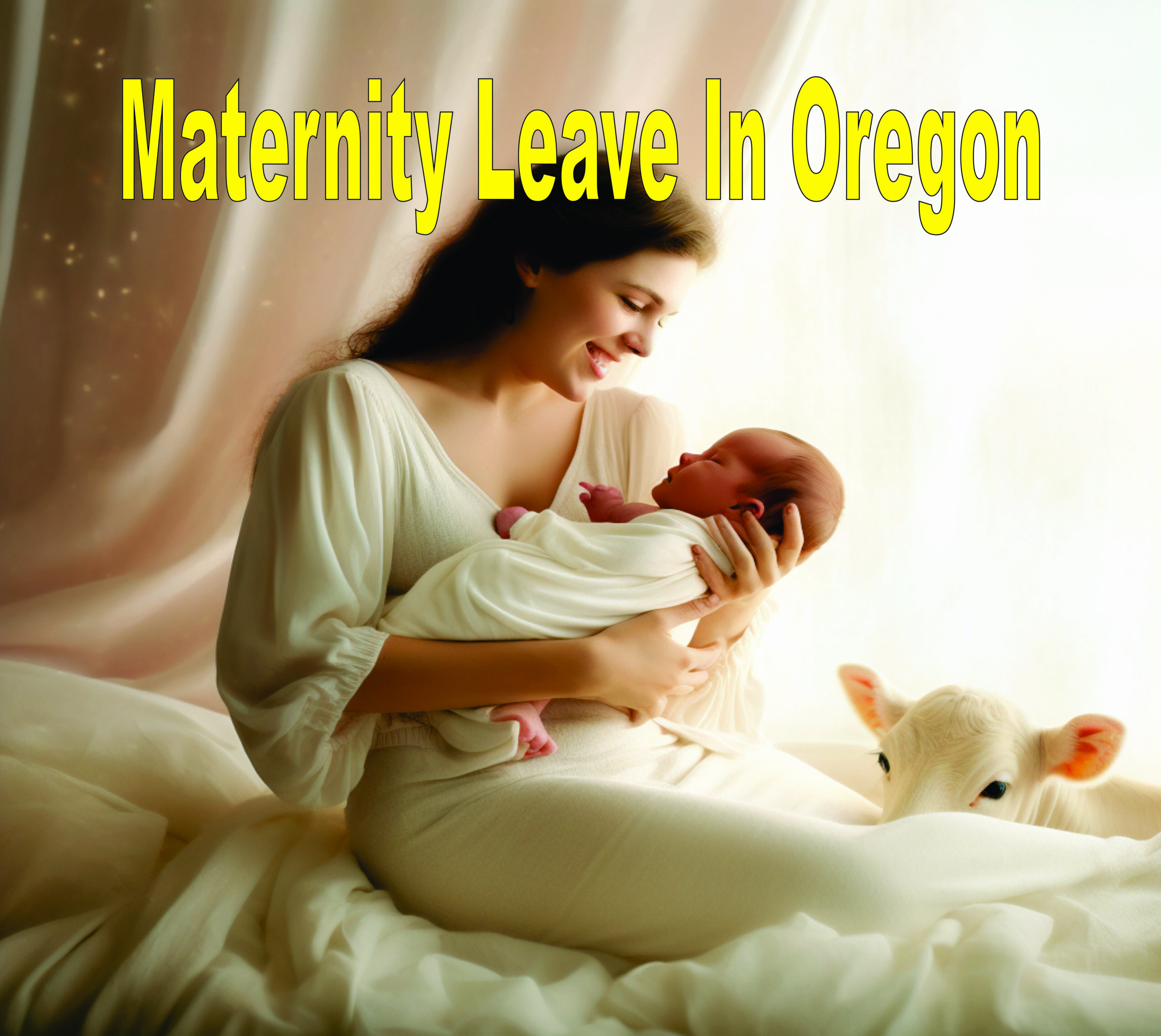Last Updated on January 16, 2024 by Lori Pace
Oregon became the eighth state in the country (plus Washington D.C.) to pass a paid family leave law in 2019, and it’s considered the most generous and inclusive in the country with respect to reimbursement and eligibility. Both employers and employees begin making payroll contributions on January 1, 2022, and benefits eligibility begins on January 1, 2023. Even better, the paid leave isn’t just for parents of new babies—there are a variety of reasons an employee can utilize the benefit, including caring for themselves or a relative.
Oregon Paid Family Leave
Similar to programs in other states, eligibility is based on where people work, not live. There are very few—if any—carve-outs to the law; anyone who has worked in Oregon and made at least $1,000 in the past year is eligible.
What is the maximum amount of paid maternity leaves I can take?
As someone who has personally experienced Oregon’s new paid family and medical leave program, I can attest that it offers an invaluable opportunity for parents to bond with their newborn children. The program provides 12 weeks of parental leave at a partial salary, and I found this time to be incredibly valuable for nurturing the parent-child relationship. Moreover, I also discovered that birth mothers could receive an additional two weeks of paid leave if they experienced any pregnancy-related conditions or complications connected to childbirth.
OFLA used to offer unpaid family leave only to workers with employers having more than 25 employees, leaving out a significant portion of the workforce due to Oregon’s status as a small employer state. However, with the introduction of the new paid leave law, all employees are now eligible for the benefit, irrespective of their employer’s size. This change represents a significant improvement, making paid family leave accessible to a much broader range of individuals.
Employees would be able to take an additional four weeks of unpaid leave under OFLA after the paid leave period has expired under the new state law. This requires a qualified reason under OFLA as well as meeting the employment qualifications under OFLA which are more restrictive than the paid-leave benefit.
Many people, particularly women, need more than 12 weeks leave. It’s a good thing to have the option of extra time even though it’s not paid, and knowing that you can still keep your job.
Who is eligible for paid family leave?
Oregon residents who have earned at least $1,000 the year before are eligible for paid family leave. However, federal employees are not eligible. Eligibility is not determined by residency alone. Oregon residents who work in another state are not eligible.
An employee must have earned approximately $1,000 in Oregon in the last year to be eligible for the paid-leave benefit. This sum can be obtained through multiple jobs with different durations. This is in contrast to other paid leave laws such as FMLA which require that an employee work for a specific amount of time.
What amount will I get paid?
Oregon’s leave program is the most generous. The average weekly wage (AWW) is used as the benchmark to reimburse. A worker earning less than 65% (or the minimum wage) will be eligible for 100% reimbursement. An employee earning $15 an hour and working 40 hours per week would be eligible for a $600 weekly payment.
You will be reimbursed if you make more money than the minimum wage. The reimbursement is based on a sliding-scale system. You will get 100% of your wages up to 65 percent% of the state’s AWW. After that, 50% for every dollar earned above that. The maximum payment is 120% of the AWW or $1,311 for 2021.
Can I use my paid family leave to care for someone else other than a newborn baby?
Yes, you can take 12 weeks of paid leave to recuperate from an accident, illness, or surgery, get treatment for an illness like chemotherapy or dialysis, or care for a loved one who is sick.
Oregon’s Paid Family Leave law provides for up to 12 weeks of paid leave to cover “safe leave” to deal with domestic violence, stalking, and sexual assault.
Oregon law does not allow family members to take paid leave if they have an exigency related to active duty, call for military service, or care for a loved one who is injured while serving in the military. Employees will still be eligible for unpaid leave under OFLA.
Do I need to use all my leave at once?
No, you do not. I personally found the flexibility of Oregon’s paid family leave program to be particularly beneficial. The leave is valid for up to 12 months and can be utilized for various purposes, including fostering a child, welcoming a new baby, or going through an adoption process. Moreover, I discovered that the benefits can be used either consecutively over several weeks or days, or intermittently in specific situations. This adaptability allowed me to plan my leave in a way that best suited my family’s needs, making the experience truly fulfilling.
What if I foster, adopt, or use a surrogate? Are those qualifying events?
Yes. Fostering, adopting, or having a surrogate child is eligible for the 12 weeks of paid Oregon leave.
Who is included in taking time off for family members?
Oregon has many people that are considered family. This includes anyone who is a member of your family or someone who shares a “family-like relationship” with the employee.

How is the benefit paid for?
Oregon’s paid leave benefits are paid by both employee and employer contributions. Employers and employees will each pay a small payroll tax to the insurance fund starting January 1, 2022. Employers will pay 0.4% of employees’ wages to the fund. Employees will pay 0.6% of their wages to fund. This totals 1% of the employee’s total wages.
Can my employer opt out of the program?
Employers with less than 25 employees may opt out of the employer contribution. Small employers can opt to pay the employer contribution. They may be eligible for state grants to offset costs such as replacing employees.
Non-participating employees of employers who have opted out of the program are still eligible and would pay the 0.6% payroll taxes.
Employers of all sizes can opt out of the program if they offer a private program that is comparable or better and has been approved and regulated by the state.
If my company pays for some portion of my leave, can the state law cover the rest up to 100 percent of my salary?
During my exploration of Oregon’s paid family leave, I came across a common concern about how the state law interacts with employer-provided benefits. The details of this interaction are still being worked out, but based on my understanding, employers are likely to be eligible for state-supported compensation that complements their existing paid family leave benefits.
Other states with similar programs have adopted a comparable approach. This means that while employers can continue to provide their benefits, the state law ensures that employees’ needs are met by covering potential gaps. The goal is to guarantee a comprehensive and supportive family leave experience for all eligible individuals.
Is the leave pay taxed?
From my personal experience with Oregon’s Paid Family Leave program, I can share that the details regarding taxes and withholdings are currently being fine-tuned. While some aspects are still under development, rest assured that the state is committed to ensuring a fair and well-structured system. By carefully crafting the taxation process, Oregon aims to provide a dependable and transparent program that benefits both employees and employers.
What do I have to do to get the money? How am I paid?
The process for submitting a claim under unemployment benefits is similar. An employee who needs to use paid medical and family leave must submit a claim to the Oregon Employment Department. This will verify eligibility and determine the wage substitution. In preparation for their absence, an employee must notify their employer about their claim for paid family or medical leave.
Are there any monetary caps on the benefit annually or during one’s lifetime?
There is no lifetime or annual cap. The reimbursement benefit is capped at 120$ of the state’s Average Worker Wage for a maximum 12-week period. Along with the option to increase to 14 weeks for a pregnancy or childbirth-related problem.
Do I still receive my benefits and job protection while I’m out?
I found it reassuring to know that the program not only provides monetary benefits but also offers job protection and ensures that employees can retain their essential benefits. This level of support is akin to the reliable protection offered by federal FMLA benefits, providing a safety net for employees during significant life events. The program’s commitment to safeguarding both financial security and job stability further strengthens its reliability, making it a dependable resource for individuals during crucial moments in their lives.
What about self-employed and freelancers, do they qualify for paid leave?
There is no minimum time required to be enrolled to utilize the benefit. However, I learned that individuals must have contributed to the system for at least three years to be eligible. These insights highlight the evolving nature of the program and the ongoing efforts to ensure it meets the needs of the community. The fact that the law is still being refined shows the dedication of policymakers to creating a robust and responsive family leave system for the state’s residents.
How has COVID-19 changed anything on the Oregon Paid Leave plan?

As someone who witnessed the impact of the COVID-19 pandemic on family and work life, I can affirm that Oregon’s paid family leave program remained steadfast in its commitment to supporting families despite the challenges. The program’s details and timeline remained unchanged during this period, demonstrating its stability and reliability.
Moreover, it became evident during this time that Oregon’s comprehensive definition of family and the flexibility of the program to accommodate various situations, such as illness recovery, were essential. The pandemic heightened awareness of the necessity for such supportive policies, and it is reassuring to know that Oregon continues to prioritize and provide this crucial benefit to its residents.
Where do I go if I have more questions?
I highly recommend visiting Familyforwardaction.org, an esteemed nonprofit grassroots advocacy organization dedicated to paid family leave in Oregon. Additionally, I found valuable and comprehensive information on the state’s official website, where detailed paid family leave guidelines are provided. These reputable sources offer reliable insights, making it easier for individuals to access accurate information about the program and make informed decisions.

